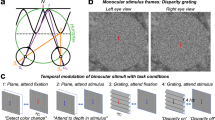Abstract
Binocular disparities arise from positional differences of scene features projected in the two retinae, and constitute the primary sensory cue for stereo vision. Here we introduce a new computational model for disparity estimation, based on the Green’s function of an image matching equation. When filtering a Gabor-function-modulated signal, the considered Green’s function yields a similarly modulated but shifted version of the original signal. Since a Gabor function models the receptive field of a cortical simple cell, the Green’s kernel thus allows the simulation of relative shifts between the cell’s left and right binocular inputs. A measure of the local degree of matching of such shifted inputs can then be introduced which affords disparity estimation in a similar manner to the energy model of the complex cortical cells. We have therefore effectively reformulated, in physiologically plausible terms, an image matching approach to disparity estimation. Our experiments show that the Green’s function method allows the detection of disparities both from random-dot and real-world stereograms.
Similar content being viewed by others
References
Adelson EH, Bergen JR (1985) Spatiotemporal energy models for the perception of motion. J Opt Soc Am A 2:284–299
Ahlvers U (2005) Stereobilder Datenbank. http://www.hsu-hh.de/ant/index_pfbUvcu5lULdjkEN.html. Cited 10 October 2006
Barnard ST (1986) A stochastic approach to stereo vision. In: Proceedings of the fifth national conference on artificial intelligence. MIT Press, Cambridge, pp 676–680
Chen Y, Qiang N (2004) A coarse-to-fine disparity energy model with both phase-shift and position-shift receptive field mechanisms. Neural Comput 16:1545–1577
CMU-VASC (1997) Carnegie Mellon University Image Database. http://www.cs.cmu.edu/afs/cs/project/vision/vasc/idb/www/ html_permanent//index.html. Cited 10 October 2006
Ferreira Jr PE, Torreão JRA, Carvalho PCP (2004) Data-based motion simulation through a Green’s function approach. In: Proceedings of SIBGRAPI/SIACG 2004. IEEE Computer Society, Los Alamitos, pp 193–199 (see http://www.graphics.ufba.br/FAPESB/motion/)
Ferreira Jr PE, Torreão JRA, Carvalho PCP, Vieira MB (2007) Motion synthesis through 1D affine matching. Pattern Anal Appl (in press)
Fetter AL, Walecka JD (1980) Theoretical mechanics of particles and continua. McGraw-Hill, New York
Fleet DJ, Jepson AD, Jenkin MRM (1991) Phase-based disparity measurement. Comput Vis Graphics Image Proc 53(2):198–210
Fleet DJ, Wagner H, Heeger D (1996) Neural encoding of binocular disparities: energy models, position shifts and phase shifts. Vision Res 36(12):1839–1857
Henkel R (2004) Stereo vision. http://axon.physik.uni-bremen.de/research/stereo/difficult/index.html. Cited 10 October 2006
Horn BKP, Schunck BG (1981) Determining optical flow. Artif Intell 17:185–203
Hubel DH, Wiesel T (1962) Receptive fields, binocular interaction and functional architecture in the cat’s visual cortex. J Physiol 160:106–154
Marcelja S (1980) Mathematical description of the responses of simple cortical cells. J Opt Soc Am A 70:1297–1300
Marr D, Poggio T (1979) A computational theory of human stereo vision. Proc R Soc Lond B 204:301–328
Ohzawa I, DeAngelis GC, Freeman RD (1990) Stereoscopic depth discrimination in the visual cortex: neurons ideally suited as disparity detectors. Science 249:1037–1041
Ohzawa I, DeAngelis GC, Freeman RD (1997) Encoding of binocular disparity by complex cells in the cat’s visual cortex. J Neurophysiol 77:2879–2909
Poggio GF, Fischer B (1977) Binocular interaction and depth sensitivity of striate and prestriate cortex of behaving rhesus monkey. J Neurophysiol 40:1392–1405
Pollen DA, Ronner SF (1983) Visual cortical neurons as localized spatial frequency filters. IEEE Trans Syst Man Cyb 13(5):907–916
Prazdny K (1985) Detection of binocular disparities. Biol Cybern 52:93–99
Qian N (1994) Computing stereo disparity and motion with known binocular cell properties. Neural Comput 6:390–404
Qian N, Mikaelian S (2000) Relationship between phase and energy methods for disparity computation. Neural Comput 12:303–316
Qian N, Zhu Y (1997) Physiological computation of binocular disparity. Vision Res 37(13):1811–1827
Scharstein D, Szeliski R (2002) A taxonomy and evaluation of dense two-frame stereo correspondence algorithms. Int J Comput Vision 47(1–3):7–42
Stork DG, Wilson HR (1990) Do Gabor functions provide appropriate descriptions of visual cortical receptive fields? J Opt Soc Am A 7:1362–1373
Torreão JRA (2001) A Green’s function approach to shape from shading. Pattern Recognit 34:2367–2382
Torreão JRA (2003) Geometric-photometric approach to monocular shape estimation. Image Vision Comput 21:1045–1061
Torreão JRA, Amaral MS (2006) Efficient, recursively implemented differential operator, with application to edge detection. Pattern Recognit Lett 27(9):987–995
Author information
Authors and Affiliations
Corresponding author
Additional information
Partially supported by CNPq-Brazil.
Rights and permissions
About this article
Cite this article
Torreão, J.R.A. Disparity estimation through Green’s functions of matching equations. Biol Cybern 97, 307–316 (2007). https://doi.org/10.1007/s00422-007-0174-0
Received:
Accepted:
Published:
Issue Date:
DOI: https://doi.org/10.1007/s00422-007-0174-0




